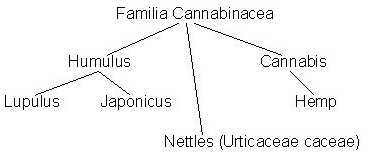
HOPS: The Bitter Herb
| University of Atlantia | Master Rhys Terafan Greydragon |
| terafan@greydragon.org |
Hops were first used in beer in Asia 10,000 years ago
It appears that hops were used in Babylon before 200 AD. Hops Latin name appears in records of Jews’ captivity in Babylon. They mention sicera (strong drink) ex luplis confectam (made from hops).
Hops spread into Europe from Asia through Eastern Europe. The most consistent fact about the spread of hops is that in almost every country, the use of hops was resisted.
Hops are a distant relative of stinging nettle and cannabis. This is a major reason for the relaxing effect of hops. They have been used for insomnia since their earliest mention in literature.

| The hop has its place in folklore. Along with the animals who are supposed
to receive the gift of speech late on Christmas Eve, the hop is supposed to turn green in
the same night. The first mention of hops is in reference to a hop garden in the Hallertau district in 736 AD. The first EUROPEAN mention of hops being added to beer was in 1079 by Abbess Hildegarde of St. Ruprechtsberg. "If one intends to make beer from oats, it is prepared with hops. Brewing was traditionally a monastic task, and much mention is made of hops gardens in monasteries. In Germany which was the center from which hops conquered all Europe, it was not until the 13th century that the traditional flavoring of gruit was seriously threatened. In some places, like Cologne, monopolistic rights were associated with gruit, generally the Church’s. The Archbishop of Cologne possessed the "Grutrecht" (gruit rights) and tried to suppress the use of hops, which of course the brewers saw as a commercial as well as technical advance. |
 |
While the composition of gruit was subject to local variations, it commonly contained bog myrtle, rosemary, yarrow, alecost, and many others. The herbs were not chosen only for their flavor, but for their reputed medicinal properties as well.
The hopped beer of the Middle Ages was extremely heavily hopped. 7 lb. to the hogshead, or 5 lb. to the barrel were not uncommon.
Records reflect the use of hops in beer in France in 1268 during the reign of Louis IX. the law stated that beer should only contain good malt and hops.
In Holland, by the 14th century, the Netherlanders had already developed a taste for Hamburg beer, which was hopped beer, in contrast to the normal Dutch beer, which was still based on gruit.
The Dutch nobility tried to exclude foreign beers by prohibition and high import duties, but the reputation of Hamburg beer as so great, that it all came to naught. In 1376 there were no less than 126 ‘braxatores de Almsetlredamme’ (Amsterdam breweries).
The Dutch were apt pupils and by 1517, Antonio de Beatis stated the "the beer in these regions is better than in Germany and brewed in larger quantity."
The English developed a taste for hopped Dutch beer while soldiering in the Low Countries. Hopped beer, or beer (as opposed to ale) was imported into Winchelsea as early as 1400, with the first hops being planted in England in 1428.
In 1524, hops were condemned as an adulteration by Henry VIII, and an injunction against their use was issued. However, in 1536, Edward VI (Henry’s successor) commended hopped beer as "notable, healthy, and temperate."
The Brewer’s Company, formed in 1437 and made up of ale brewers, concerned about the spread of beer petitioned the Lord Mayor of London in 1484 that "no hops, herbs, or other like thing be put into any ale or liquore wherof ale shall be made--but only liquor, malt, and yeast." This was intended to keep clear the demarcation between ale and beer.
In 1493, the beer brewers themselves became a definite craft (guild) and ale and beer were to remain quite distance for over 100 years.
Although unhopped ale had ceased to be brewed in England by the sixteenth century, it could still be found in Scotland. We read of Jerome Cardan, a French physician, who traveled to Scotland in 1552. He frequently mentions food and approves of Scotch ale and says that it "it differs from beer in the omission of hops."
ADVANTAGES OF HOPPED BEER
Beer was the one drink that had been sterilized and was safe to drink.
Prior to hops, the stronger (more alcoholic) beer was, the longer it kept. The addition of hops is a preservative, thus allowing beer to be weaker and still keep longer.
Hops allowed you to produce more beer from the same amount of malt. Reynold Scot, in A Perfite Platforme for a Hoppe Garden, states "whereas you cannot make above 8-9 gallons of a very indifferent ale from a bushel of malt, you may draw 18-20 gallons of very good beer."
Hops also aid in clarification as well as head retention.
SOURCES
Scot, Reynold, A Perfite Platforme for a Hoppe Garden, London, 1574
Harrison, William, A Description of England, England, 1577
Plat, Hugh, The Jewel-house of Art and Nature, Peter Short, London, 1594
Digby, Sir Kenelme, The Closet Opened, England, 1615
Coran, H.S., The History of Brewing, David and Charles, Inc, North Promfret, Vermont, 1975
La Pense, Clive, The Historical Companion to House Brewing, Montag Publications, Beverly, England, 1990
Gayre, G. Robert, Wassail! In Mazers of Mead, Gayre & Nigg, England, 1948
Papazian, Charlie, The NEW Complete Joy of Home Brewing, Avon Books, New York, 1991
![]()